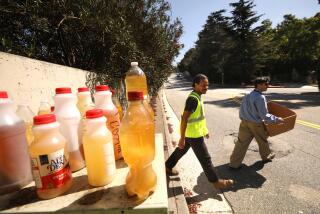NASA Is Keeping Its Eyes on Restroom Down the Hall
- Share via
HUNTSVILLE, Ala. — In the building where NASA once built giant moon rockets, workers are contributing to the space cause on a smaller, more personal scale.
They’re donating urine.
NASA needs all the urine it can get to test a urine processor for the planned international space station Alpha. There are no sewers in orbit, mind you. So station managers are advertising--pleading--for contributions in the men’s room just off the chamber where the urine, water and air-recycling equipment is housed at Marshall Space Flight Center.
“To persons using this restroom,” says a sign over one of three urinals. “Please contribute to the collection of urine. It will be used to support the ongoing urine-processing tests. Thank you.”
Donations are funneled from the urinal into a large plastic jug. About 5 gallons of urine are collected every workday, representing 50 to 60 contributions. There are no medical restrictions; anyone can donate.
“We’d process more if we had more,” said NASA engineer David Long. “Everybody in our group donates.”
Everybody, that is, except the women. There is no urine collector in the women’s room. NASA installed one a few years ago, but only one or two women donated and then only occasionally, Long said.
The urine processor, chugging away on a long workbench, is essentially an evaporation system.
The urine, treated with chemicals for preservation, is squirted from a tank into a drum that’s spinning at 300 revolutions per minute. The rotation causes the urine to spread over the drum’s interior in a thin layer. Low pressure inside the drum causes the water to boil off at close to room temperature, and a compressor causes that steam to condense at the same temperature.
The condensation comes out as water; 93% of the urine, in fact, comes back out as water. The rest--salt and minerals, or brine--accumulates on a filter that is replaced monthly.
The equipment has been running for more than two years, for six to eight hours a day. That’s enough to simulate station conditions with four crew members. Besides urine, space station crews will have to recycle their shower and other waste water.
In tests earlier this year, NASA took recycled urine and ran it through a water processor similar to what might fly on Alpha. The urine was combined with sweat, shower water and urine collected from employees. Iodine was added for purification.
The result was high-quality drinking water, said Charles Ray, deputy chief of the life-support system branch at Marshall.
The water was not tasted this time. But Long, who sampled the purified sweat, wash water and urine a few years ago, said it tastes “pretty good.”
“It’s water,” said Charles Cooper, chief of NASA’s development test branch. “Water is water.”
More to Read
Sign up for Essential California
The most important California stories and recommendations in your inbox every morning.
You may occasionally receive promotional content from the Los Angeles Times.










